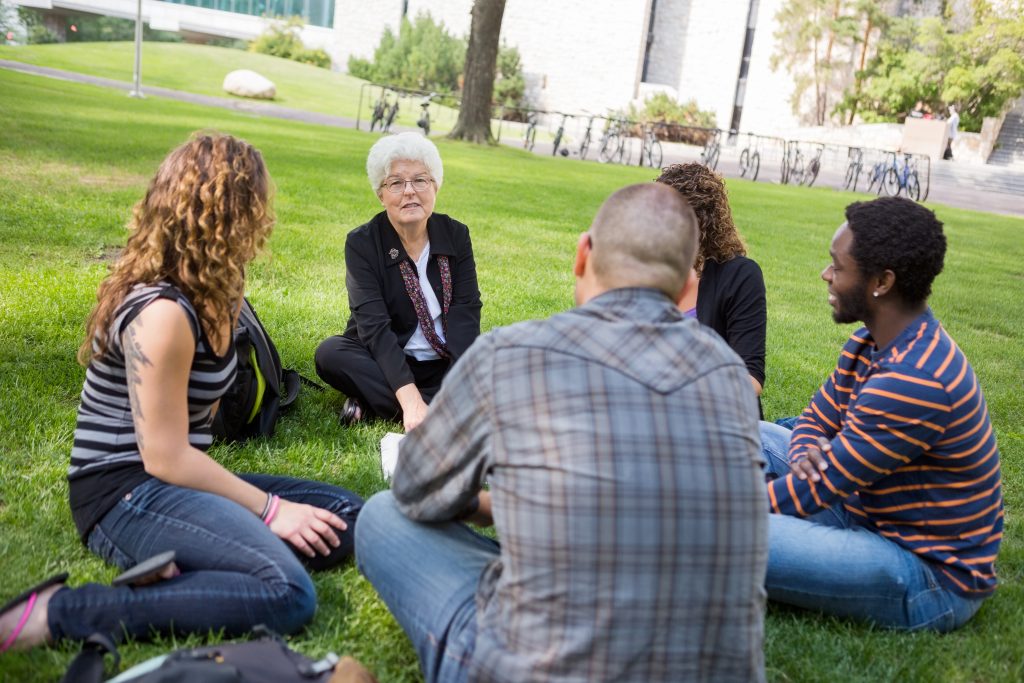Purposeful Group Work in the Classroom
One of the major trends in the teaching of writing is to have “group work.” In essence, this means that students work in small groups to accomplish a goal. One classroom is divided into multiple groups and then, the activity takes care of itself. Or does it?
A group work activity can be self-fulfilling when it is prepared well. You want to have a definite goal behind the activity because students can spot a time filler a mile off. In order to be useful and worth the money students are paying for tuition, group work needs to be planned, prepared, and executed with definite purpose in mind.
Preplanning: Why have group work?
Group work serves several purposes in the writing classroom. First of all, it can provide a change in routine. When students have to get up and locate a partner, they are being physically active. Too much sitting puts the brain on sleep mode, so waking it up by getting people out of their chairs can refresh their learning sensors.
Secondly, group work, when handled correctly, is a way to teach through example. If I can put something into a worksheet, and let students work through practice problems, it helps them remember the concept. Experience is a great teacher, and physical reminders, like a completed worksheet, are easy to review when students are working on papers.
Lastly, some students really do learn best when they can talk over things. While they may not raise their hands to ask the instructor a question, when some students are in a peer group, those questions have more of a chance to crop up, and the individuals may be less inhibited about asking them. Or, a more outspoken student will learn about the question and will ask it.
Group work, when used in this way, becomes a verbal and kinesthetic experience. There is room for the quiet student who prefers to take notes; but it allows students who excel at other learning methods to use their strengths, as well.
Step One: Setting the Goal of Group Work
What do you want to accomplish with a group work project? A lot of things are teachable through this exercise, way beyond the limits of “peer critiquing” papers. Think about some of the major concepts that you want to teach in your course, and choose one of them to experiment with as a group activity.
The next point to tackle is, how do you want to divide up the groups? This really depends on the size and flexibility of your classroom. If your classroom is full of wheeled desk chairs, then mobility should be no issue. Students will be able to get up, shift chairs around, and make enough room for themselves without endangering the fire code.
If, however, you are in a room that has long, immoveable tables with chairs bolted to the floor, this presents a different challenge. In this case, if there is enough room to get up and find another seat, mobility is still possible. But if the room is rather tight, you may want to move the activity to another room altogether, like the library or a nearby conference room that you can reserve.
Step Two: Dividing the Groups
This is the place for some creativity. There is, of course, the standard “count off” method, whereby students number themselves and split up in that way. But, if the room has a number of pillars in it, or there are more than 15 students in the room, this can be challenging.
A different method would be to print out lists of ideas that go together, cut up the lists, put the pieces in an envelope, and hand the envelope around the classroom. This works very well for pairing students into teams of two, three or four. (Groups of five or more usually don’t work, because there is too little work for too many people).
So: look up famous pairs on Google, like food names (spaghetti and meatballs, macaroni and cheese, etc.) or famous artists (Vincent Van Gogh, Claude Debussy, Victor Borge). Make a list of these names or words that matches the number of students that you expect will come to class. Use your department’s paper slicer to make the cutting easier, if you want the edges to be straight or you don’t want to do that much scissor work.
Pro tip: have a few slips extra, just in case more students arrive than you had anticipated. Inevitably, when you have had a class attendance of about 17, on the day you do group work, 21 will arrive. Do a head count before you issue the envelope and add or subtract slips as needed. There’s nothing like informing the class that they will look for their matching partner – and then having several slips left in the envelope and three people with only half a team. Be diplomatic in this case: Batman may be Robin-less, and Ethel may find no Lucy, but there’s nothing saying that Batman and Ethel can’t form a team.
Step Three: Crafting the Exercise
Zero in on your activity. Let’s use the experience of teaching different argumentative writing styles. For this exercise, you will want several short articles that demonstrate a different style of argumentative writing. One article could be a proposal piece, another a causal piece, a third a position article.
This exercise will work best after you have introduced these ideas to your students; if they have notes they can review, explaining the difference between argumentative types, then you are in a good place for a group exercise.
Print out enough articles for each group. If you have teams of two, you can sometimes stretch the paper by handing out one copy to each team. But if you have several people per group, try to provide enough articles for all participants, so that they are not stalled out, waiting for one reader to broadcast the text to the group. When everyone has something to do, no one can get restless.
Give clear instructions for what you want students to do with the article. It may work best to have these instructions posted on the projector screen or white board, so they can look up and think through things as they read. Or, you can print out the instructions and hand them out, too.
Questions to ponder about the articles could include the following: what argumentative style is demonstrated by this article? How does the writer provide evidence? How does the writer prove that he or she is trustworthy – through evidence, the caliber of the publication, sources listed, or something else?
Step Four: Using the Exercise
Conduct class in your regular way. When you have reached a turning point, or there is a lull in students’ attention, pull out the envelope and explain your activity. It’s rather like being on Price is Right – students get the envelope without knowing quite what to expect.
Project the list of names up on the white board, so that people can identify with whom they are supposed to work. If someone pulls a slip out of the envelope and it says “meatball,” it won’t make much sense. But if they see the pairings or teams listed on the board, then it makes a lot more sense.
Once people have gotten into groups, distribute the readings and then let them work. You can alphabetize papers, or read a book, or do something else as they work. If they need help, you can also circulate to meet those needs.
After most of the class groups have discussed and written down their answers, you can ask them for their responses so everyone can see how each group’s analysis compared. One spokesman or several can answer from each group; this really depends on the dynamics of the group itself, and your class. For the sake of time saving, it sometimes is simpler to just have one person answer so that you will be able to conclude the class in a timely way.
Cautionary Tips to Consider
Group work is a great exercise to have once in a while. In my experience, too many group work projects can sometimes lead to ennui, especially if they are all of the same style. But if you have another type of group activity, such as having individuals create paraphrases of famous quotes, or perhaps editing text on worksheets you hand out, this is a different way to utilize the group working philosophy. As long as it isn’t a cookie-cutter approach, you can generally maintain the classroom’s level of interest by keeping things similar but different.
If you do decide to do group work, make sure that you are still being attentive to the needs of the classroom. Don’t zone out as students work. Go ahead and scan your book or read a student paper – but look up frequently. Be ready to put anything down instantly if there is a call for clarification.
One final thought: not all classes will do group work easily. Some classes are composed of students who are more comfortable sitting and listening rather than actively discussing ideas. In those cases, you will want to limit how much group work you assign. If you find that you hear a lot of crickets between questions, this is a sign that group work may not be the best option for this particular class. That’s okay: videos, lectures, and hands-on individual worksheets will probably become your go-to tools for this individual class.
Group Work as a Tool
Collegiate writing courses are designed to help students learn how to better express themselves in a variety of ways through the written (or typed) word. Any tool that helps them to see how they can make themselves clearer is a valuable thing. Group writing activities, when handled thoughtfully and with purpose in mind, can be a good part of distributing that knowledge throughout the student body. And that’s the teacher’s goal: to distribute knowledge, and to provide practice opportunities for students to improve their skills. That’s what good teaching is meant to do.



